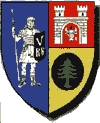Zlatna
Zlatna | |
|---|---|
 | |
 Location in Alba County | |
| Coordinates: 46°09′32″N 23°13′16″E / 46.15889°N 23.22111°E | |
| Country | Romania |
| County | Alba |
| Government | |
| • Mayor | Silviu Ponoran[1] (PNL) |
| Area | 254.26 km2 (98.17 sq mi) |
| Population (2021-12-01)[2] | 6,652 |
| • Density | 26/km2 (68/sq mi) |
| Time zone | EET/EEST (UTC+2/+3) |
| Vehicle reg. | AB |
Zlatna (‹See Tfd›German: Klein-Schlatten, Kleinschlatten, Goldenmarkt; Hungarian: Zalatna; Latin: Ampellum) is a town in Alba County, central Transylvania, Romania. It has a population of 7,490.
Administration
The town administers eighteen villages: Botești (Golddorf; Botesbánya), Budeni (Higendorf), Dealu Roatei (Rotberg), Dobrot, Dumbrava, Feneș (Wildendorf; Fenes), Galați (Galz; Ompolygalac), Izvoru Ampoiului (Gross-Ompeil; Nagyompoly), Pârău Gruiului (Gruybach), Pătrângeni (Peters; Ompolykövesd ), Pirita (Pfirth), Podu lui Paul (Pauls), Runc (Goldrücken), Ruși (Rusch), Suseni (Oberdorf), Trâmpoiele (Trempojel; Kénesd), Valea Mică (Kleinwasser) and Vâltori (Waldrücken; Vultur).
Geography
Located 36 km north-west of Alba Iulia, in the Zlatna depression, the town lies at the confluence of Ampoi River with Valea Morilor creek.
Points of interest
- 220 metres high chimney, interconnected with a smoke duct with a copper smelter (not in use any more) in the town.
History
| Year | Pop. | ±% |
|---|---|---|
| 1977 | 10,027 | — |
| 1992 | 9,391 | −6.3% |
| 2002 | 9,254 | −1.5% |
| 2011 | 7,182 | −22.4% |
| Source: Census data | ||
A gold mining settlement has existed in the area since Roman times, when it was known as a municipium under the name of Ampellum. The name Zlatna (derived from the Slavic term for gold) was first recorded in a 1347 document. In 1387, it was awarded town status. During 1619-1620 Gabriel Bethlen, brought to Zlatna a few hundred German and Slovak settlers for mining work. Tellurium was first discovered in a Zlatna mine in 1782 by Austrian mineralogist Franz-Joseph Müller von Reichenstein. Zlatna regained its town status in 1968, after a time when it was officially a commune.
References
- ^ "Results of the 2016 local elections". Central Electoral Bureau. Retrieved 3 April 2020.
- ^ "Populaţia rezidentă după grupa de vârstă, pe județe și municipii, orașe, comune, la 1 decembrie 2021" (XLS). National Institute of Statistics.
![]() Media related to Zlatna at Wikimedia Commons
Media related to Zlatna at Wikimedia Commons



